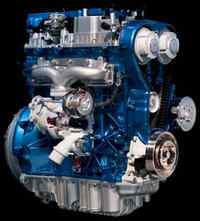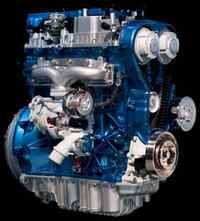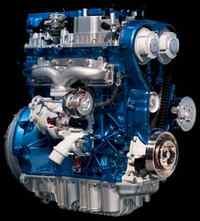Next Generation of Ford's EcoBoost Engines Promise Even More Power, Better Fuel Economy
DETROIT, April 14, 2010; At the 2010 SAE World Congress this week, Dan Kapp, Ford's director of powertrain research and advanced engineering, and Bob Fascetti, director of large gas and diesel engine engineering, will detail how the next generation of the company's award-winning EcoBoost engines will further connect gasoline and diesel engine technology.
"The first generation of EcoBoost applied some of the key technologies found in powerful diesel engines - such as direct injection and turbocharging - and optimized them for the gasoline engine," said Fascetti. "The next generation of EcoBoost engines will continue that path to deliver more power and even better fuel economy with lower emissions, which are key customer benefits of EcoBoost technology."
Technologies being studied to further expand the potential of EcoBoost include cooled EGR and more advanced forms of turbocharging, which also have links to modern diesel engines. Cooled EGR as applied to an EcoBoost engine can improve efficiency and reduce the tendency for an engine to knock. Cooled EGR is exhaust gas that is cooled in a heat exchanger before being pumped back into the cylinders, where it lowers the combustion temperature.
The result: a cleaner-running engine that develops more power and delivers as much as a 5 percent gain in fuel economy over today's already efficient EcoBoost engines. Ford's current generation of 2.0-liter EcoBoost I-4 and 3.5-liter EcoBoost V-6 engines deliver between 10 and 20 percent better fuel economy than comparable normally aspirated V-6 and V-8 engines, respectively.
Ford holds more than 125 patents on its EcoBoost technology, which combines direct injection, turbocharging and variable valve timing to increase performance and reduce emissions. EcoBoost gasoline engines already use much of the same technology that is found in today's state-of-the-art turbo-diesels.
As with diesels, today's EcoBoost engines feature:
-- A high-pressure direct-injection fuel system fed by a common rail that
delivers a precise amount of gasoline in the exact spot for fast and
complete burn
-- Turbocharging to create a more dense mix of air and fuel in each
cylinder
-- Special pistons with optimized bowls in the center to improve
combustion efficiency. These pistons are also oil-cooled, which
reduces in-cylinder temperatures
-- Reduced CO2 emissions and higher fuel economy
And just like diesels, Ford's EcoBoost engines deliver outstanding performance and driving enjoyment at all speeds. EcoBoost accomplishes this at less cost than a similar-displacement diesel engine.
"When it comes to smaller-displacement engines, EcoBoost is the perfect solution for most consumers," said Barb Samardzich, Ford's vice president for Powertrain Engineering. "EcoBoost delivers what customers need most - outstanding fuel economy and low-end torque."
Adapting diesel engine technology to a gasoline engine involves more than simply machining a few new parts and then just bolting them on, explained Brett Hinds, manager of Ford's advanced engine design.
"An EcoBoost engine has much higher operating temperatures than a diesel engine," said Hinds. "Many parts had to be upgraded to special metals and alloys that hold up to that environment. Our exhaust manifolds, for example, are made of stainless steel, and the turbochargers are made from high-temperature cast-iron alloy."
EcoBoost and diesel engines share higher pressures in the fuel system and higher compression ratios. For example, a regular port fuel-injected gasoline engine's fuel pressure is around 65 psi, while the pressure at which the fuel is delivered through the injectors in an EcoBoost engine can be as high as 2,250 psi.
State-of-the-art diesel engines, such as the new Ford-designed and Ford-built 6.7-liter Power StrokeŽ V-8, have fuel pressures that are even higher. But in both engines, the fuel is delivered to almost the exact same area. With EcoBoost, the fuel is introduced directly into the cylinder head, just like a diesel, and the fuel injection tip is right in the combustion, just like a diesel.
"We're introducing about 30 powertrains over the next couple of years to power everything from small cars to large pickup trucks," said Fascetti. "Our experience with a wide range of engines allows us to take the best solutions and apply them to many platforms to benefit the customer."
About Ford Motor Company
Ford Motor Company , a global automotive industry leader based in Dearborn, Mich., manufactures or distributes automobiles across six continents. With about 198,000 employees and about 90 plants worldwide, the company's automotive brands include Ford, Lincoln, Mercury and, until its sale, Volvo. The company provides financial services through Ford Motor Credit Company. For more information regarding Ford's products, please visit www.ford.com.





